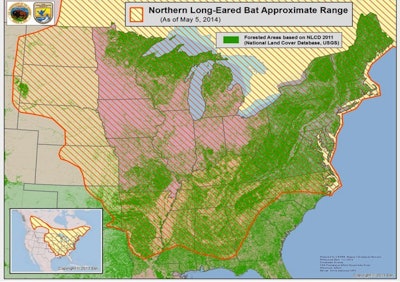
Last week I walked the Hill with colleagues from the flooring, lumber, panel, and other wood industries for the Hardwood Federation Fly-In. We had several items on the agenda, but the key one was the situation with the Northern long eared bat (NLEB).
The U.S. Fish & Wildlife Service has proposed adding the NLEB to the endangered species list. And absolutely, the bat is threatened. It is, as are many bat species, facing a serious decline in population. However, in the case of the NLEB (and many of the other bats) the threat is coming from a disease known as the white nose syndrome (WNS). The disease is a type of fungus that grows in caves and mines where the bats hibernate during the winter. When the disease infects the bats, it wakes them up and they starve to death, since there is insufficient active insect population to feed them. It is believed that WNS was brought to the U.S. by European cavers who accidentally carried it in on their shoes and other caving equipment.
Note: It is a disease that is killing the bats, and that disease is located in caves, where trees do not grow. There is absolutely no suggestion by anyone that logging activities spread the disease or otherwise harm the bats. In fact, there are several studies that show that selective harvesting helps the bats because it opens up the canopy, allowing more insects to fly up to where the bats are hunting.
So, logging is not just doing no harm; it can even be helpful.
So, logging is not just doing no harm; it can even be helpful. Therefore it makes no sense to place the bat on the endangered species list, which results in a virtual shutdown of all logging activities for up six months of the year in 39 states.
Yes, you read that right, no timber harvests for up to 6 months in 39 states. Here’s a map of the bat’s range:

Do you see your facilities or some of your timber supply within this area?
If not, wait a while—the map might expand. I was in a cave in Oregon a few months ago, and the Forest Service there was asking people to clean their shoes and take other precautions to prevent the spread of WNS. So it is possible that WNS could move into the Western states as well. And as all will remember, the PNW has already been through this type of situation with the listing of the Northern spotted owl in 1990.
The bat IS threatened. It just isn’t threatened by us, the wood industry.
The thing is, without question, the bat IS threatened. It just isn’t threatened by us, the wood industry. Or any of the industries that might be impacted—utility companies, energy companies, agriculture. Directly addressing the problem is necessary, but a listing of any type is not really appropriate. A listing as “threatened” or “endangered” can shut down industry without helping the bat at all, because it doesn’t address the actual cause of the problem.
However, the Hardwood Federation is asking that if it must be listed so the government takes action to help, the NLEB be designated as “threatened,” an official ranking that would provide more flexibility for companies operating within habitat areas. But more importantly, we’re asking that money go toward developing a cure for WNS. Apparently Georgia State University has two possible treatments they hope to field test, which would be terrific, because, actually, those of us in the wood industry kinda like bats. They eat a lot of insects that would otherwise be snacking on us! So when the Federation sends out a call to participate in the campaign to save the bat, please answer it. An endangered species listing could be disastrous, and it’s completely inappropriate. We need to cure WNS, not stop beneficial logging operations in over half the country.
As a quick note, other Federation activities during the Fly-In included:
• working on crafting tax reforms that will both help small businesses and avoid hurting timber owners who are making very long term and high risk investments in trees;
• encouraging competition among green building rating systems for federal building projects.;
• reform of the U.S. Forest Service budget system (half their funds go to forest fire suppression rather than sustainable management of the forests—this needs to change so that we can both use and protect one of our greatest national resources);
• monitoring the EPA’s recently released rule on the federal Clean Water Act authority and its possible impact on the hardwood industry.
And here are a few more pics of your representatives in DC—hope to see YOU there next year!
 A group of us from the Hardwood Federation with Rep. Derek Kilmer of Washington State.
A group of us from the Hardwood Federation with Rep. Derek Kilmer of Washington State.
 Brenda Cashion, NWFA Chairman Jeff Fairbanks, and me.
Brenda Cashion, NWFA Chairman Jeff Fairbanks, and me.
 NWFA Vice Chairman Tommy Maxwell, the Hardwood Federation's Cary Moon, and Hardwood Federation Chairman Don Finkell.
NWFA Vice Chairman Tommy Maxwell, the Hardwood Federation's Cary Moon, and Hardwood Federation Chairman Don Finkell.
































